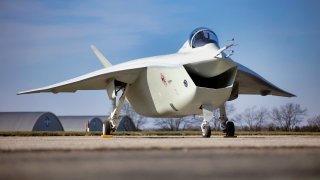Photos and Video: Why Boeing's X-32 Stealth Fighter Failed Horribly
In the late 1990s, Boeing's X-32 competed against Lockheed Martin's X-35 in the U.S. Department of Defense's Joint Strike Fighter program, aiming to create a versatile fifth-generation fighter for multiple branches and allies.
Summary and Key History You Need to Know: In the late 1990s, Boeing's X-32 competed against Lockheed Martin's X-35 in the U.S. Department of Defense's Joint Strike Fighter program, aiming to create a versatile fifth-generation fighter for multiple branches and allies.
-Boeing emphasized simplicity in its design, focusing on stealth and speed with a single-engine cycle and delta wing shape. However, the X-32's Short Takeoff and Vertical Landing (STOVL) system proved less efficient than Lockheed's lift-fan design.
-Ultimately, the X-35 outperformed the X-32 in stealth and supersonic flight, leading to its selection as the F-35 Lightning II, now a key asset in global air power.
Boeing’s X-32 and the Road Not Taken
The late 1990s saw a flurry of revolutionary advances and experiments in military aerospace. In that decade the U.S. Department of Defense initiated the Joint Strike Fighter program. The idea was to develop a fifth-generation warplane for use by the Air Force, Navy, and Marine Corps, as well as by multiple U.S. allies.
America’s premier fifth-generation warplane, the F-22 Raptor, was for the U.S. Air Force’s exclusive use. Congress explicitly forbade the Air Force from selling any variation of the F-22 to allies, including the Israeli Air Force. The F-22 was so advanced that its technological capabilities had to be kept a state secret.
The JSF program was meant to move capabilities forward while not being so complex and sensitive that its use would be limited. This was also done to tamp down on the onerous costs the F-22 program imposed. Sharing the JSF across multiple branches and foreign militaries meant the supply chain would be diverse and funded by multiple sources.
The program would eventually yield the F-35 Lightning II.
The Joint Strike Fighter Competition
Lockheed Martin’s F-35 was not a lock to be the airframe selected. When it was the X-35, the future Lightning II had stiff competition from the Boeing X-32.
As part of their bid to win the JSF race, Boeing built two prototypes, the X-32A and the X-32B. The X-32A first flew in September 2000, and the X-32B took flight in March 2001. The X-32B’s Short Takeoff and Vertical Landing (STOVL) capability made it appealing to the Navy for aircraft carrier operations.

The X-32’s design focused heavily on stealth capabilities and speed, placing it firmly within the fifth-generation family of fighter aircraft. Beyond that, Boeing focused on simplicity. The X-32 was built with a Rolls Royce single-engine cycle for both conventional flight as well as vertical lift. In so doing, Boeing planned to significantly reduce maintenance costs for the X-32.
They designed this almost beetle-looking warbird with a simplified airframe shape: a delta wing with a single, large canopy that gave pilots greater situational awareness and visibility while in combat.
Simpler System or Too Simplistic for Its Own Good?
An interesting development came in the form of the STOVL lift system. Rather than go with the standard lift fan system, which was, as Boeing surmised, needlessly complex, they decided to simplify again. But too much oversimplification ended up getting in the way of the engine’s efficiency.
More problems were found during testing of the X-32B’s STOVL flight systems. Boeing’s engineers needed to concoct methods for overcoming the increased heat and structural stress when the plane went vertical.

The bird was nowhere near as sophisticated as the F-22. Still, the X-32 was a stealth warplane. What’s more, it had speed. To enhance its flying, the bird was equipped with advanced avionics, too.
Nevertheless, the Air Force concluded that the X-35 performed better in both stealth and supersonic flight.
Boeing's X-32 Stealth Fighter: A Better Bird?
Boeing’s simpler lift-fan system for STOVL in the X-32B was nowhere near as efficient or reliable as the one Lockheed included in their prototype.
There are those who today insist that the X-32 was the better of the two. This author is not convinced.
While the F-35 Lightning II has many problems that its supporters refuse to address, it remains a powerful warbird. When compared to its Boeing counterpart, it is obvious that Lockheed got the better of Boeing, and the Pentagon made the right choice.

Author Experience and Expertise: Brandon J. Weichert
Brandon J. Weichert, a National Interest national security analyst, is a former Congressional staffer and geopolitical analyst who is a contributor at The Washington Times, the Asia Times, and The-Pipeline. He is the author of Winning Space: How America Remains a Superpower, Biohacked: China’s Race to Control Life, and The Shadow War: Iran’s Quest for Supremacy. His next book, A Disaster of Our Own Making: How the West Lost Ukraine, is due October 22 from Encounter Books. Weichert can be followed via Twitter @WeTheBrandon.
All images are Creative Commons or Shutterstock.
From the Vault
Russia Freaked Out: Why the U.S. Navy 'Unretired' the Iowa-Class Battleships
Battleship vs. Battlecruiser: Iowa-Class vs. Russia's Kirov-Class (Who Wins?)


